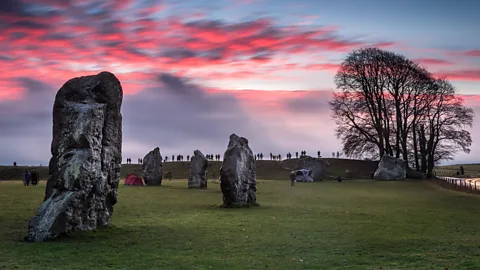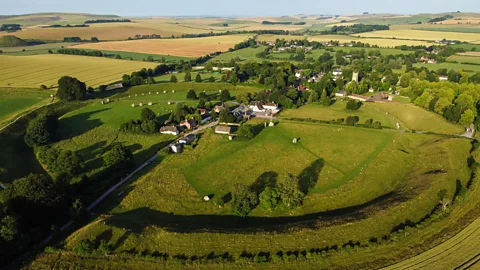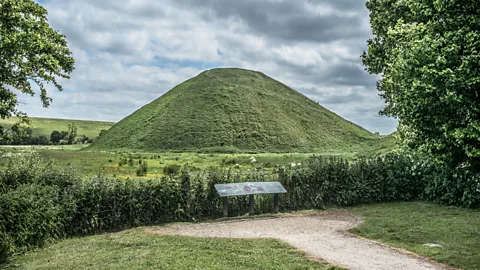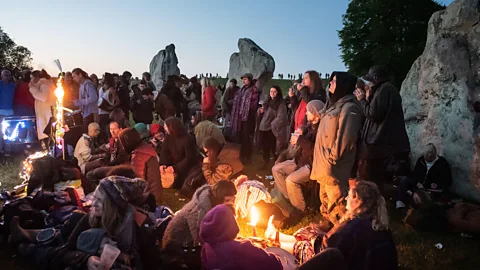The solstice site older (and bigger) than Stonehenge
 Alamy
AlamyJust 38km north of Stonehenge, Avebury draws its own annual solstice visitors who want a more up close and personal experience with Britain's ancient standing stones.
No place on Earth is quite as linked to the summer solstice as Stonehenge, the Neolithic standing stones in central England that align with the sunrise during the longest day of the year (this year on 20 June).
But just 38km north, another site, estimated to be 800 years older and 10 times larger in diameter, draws its own annual solstice visitors – especially those who want a more up-close and personal experience with Britain's ancient standing stones.
"Stonehenge is for show, Avebury is for the pro," says Alice Hues, owner of The Farm at Avebury, a generational farm and guesthouse. With its 100 original stones (not all still standing), the stone circle here is the largest in Britain, and the among the oldest, dating to 2850-2200 BCE. The entire henge completely encircles the tiny village of Avebury, which includes a handful of shops, homes and the Red Lion Pub – the only public house in the world to sit within a stone circle.
Unlike its more famous cousin where the stones can no longer be touched, the Avebury stones can always be freely approached. Ranging in height from 3.6m to 4.2m, the tall sarsen stones offer a portal back in time.
"I love Stonehenge, but it's always a bit of a conveyor belt – you have to be on a little trail and then get snapped back at the end," says Lally MacBeth, co-founder of The Stone Club, which offers gatherings and events for standing stone enthusiasts. "At Avebury, you can go right up the stones. You have time to do a drawing, or you could write something and you wouldn't be disturbed. It feels very spacious."
 Getty Images
Getty ImagesIn particular, the solstice draws more young families, as the vibe here is laid back and less hedonistic. "It's a safe space to attend and share the magic of summer solstice with younger children," says Donna Byatt, owner of the shop Elements of Avebury. "Many will bring a picnic blanket and watch the Kings Drummers as they drum down the Sun on the evening of the solstice."
More than a moment
If seeing both stone circles is a priority, you can catch the spectacular dawn Sun show at Stonehenge on the solstice, and then drive 40 minutes to Avebury for more leisurely exploration. With fewer tourist hordes, the latter site offers both the time and space to step back into history.
How to get here
It's easiest to drive, but trains run from London to Swindon, the closest station, and then taxis or buses are easily accessible. Keep in mind that buses stop running from the stone circle before midnight, so plan ahead if you plan to stay late with the revelers.
The stone circle is just one of many Neolithic and Bronze Age sites here. The town is covered in ancient human landmarks — like the West Kennet Long Barrow, one of Britain's largest chambered tombs; Silbury Hill, a mysterious human-made hill that still confounds archaeologists in its presence and purpose; and Windmill Hill, where ancient animal bones in concentric ditches suggest a place of feasting or trading.
While there's not the breathtaking stone-Sun alignment at the summer solstice, Avebury's stones and landscape speak to the cycles of life, which naturally connects to the cycles of the seasons and the solstice, says Matthew Shaw, also a co-founder of The Stone Club. "I spent one solstice with Michael Dames who wrote The Avebury Cycle in the 1970s and he explained how the landscape connected to a human life."
In Dames' theory, Silbury Hill represents the pregnant Earth, the prime of summer and solstice; looking into the stone circle represents looking on the autumn or harvest of your life; West Kennet Long Barrow represents the end of life and winter, while Swallowhead Springs – a holy spring and well — represents the birth of new life and the renewal of the spring.
 Getty Images
Getty Images"[Dames] influenced our idea that you can lay a cycle of a year in the cycle of your own life in relation to physical sites in the landscape," says Shaw. "In Avebury, you could walk a lifetime in two and a half to three hours and take yourself through that cycle."
It's a landscape that's well worth exploring during the longest day of the year, especially if the weather holds up. The history of the site and the stone circle can be experienced at the small but informative Alexander Keiller Museum, but the rest of the sites feel much more organic, meant to be experienced physically rather than intellectually.
Where to eat
Stop for a pint at the Red Lion, the only public house in the world located within a stone circle, and sit outside on one of the many patio tables to watch the crowds roll in. A little further down the road, Waggon and Horses looks set out of time with its authentic thatched roof, and was frequently visited by Charles Dickens.
For Hues, the Long Barrow is the place that always surprises her. "It is phenomenally rich in history, but it's so accessible. You can climb amongst it or have a picnic on top of it," she says. "You can take from it exactly what you want, whether for a solstice celebration or just for a Sunday morning."
No single historical site among the vast Avebury landscape draws an abundance of crowds during the summer solstice, except for the stone circle itself. Those crowds start growing when the sun starts its long descent.
The solstice celebrations don't have a written schedule or online agenda for when festivities or the drummers start – the drum beat just begins. It's a place where no technology seems needed at all; the rhythm of the Sun and the drum drives everyone in place.
 Alamy
AlamyAs the night sets
In the centre of the stone circle, more musicians join in the primal drumbeat, a rhythm that feels connected to the thousands of years of human history here. Some people dance, some people draw; most just tap along as they sit on the grass.
"When you stand bare feet on the ground, listening to the Kings Drummers, it invokes feelings of the past, how the ancestors would have celebrated," says Byatt. "No phone devices, just a collection of people all there for the same reason."
As the Sun finally sets – this year at 21:50 on 20 June – modern-day Druids and Pagan practitioners dance and act out the metaphorical war between the darkness and the light, complete with epic live music and flames. At the end of the performance the revelry continues, with dancing and drumming continuing into the early hours of the morning.
By dawn, the crowd has thinned – but there's no rush to leave for those who want to stay. "People want to feel connected to something other than their phones and laptops, and Avebury gives that to them," says Byatt. "It's open 24/7."
--
If you liked this story, sign up for The Essential List newsletter – a handpicked selection of features, videos and can't-miss news, delivered to your inbox twice a week.
